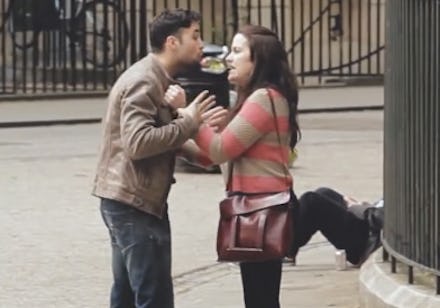This Video Will Forever Change The Way You Think About Domestic Violence

When footage emerged earlier this month of Solange Knowles physically attacking Jay Z in an elevator, many shared the video with amusement and wisecracks, turning the event into entertainment. But others rightly pointed out the double standard rooted in this behavior; if the altercation had featured a man hitting a woman, the audience would have been outraged.
That's the point the UK-based charity ManKind Initiative, along with the creative agency Dare, is making in its latest video, an eye-opening experiment examining domestic abuse.
Filmed with hidden cameras in a public place, the video first shows a man shoving and shouting at a woman, who repeatedly asks him to take his hands off her. When he pushes her up against a fence with his hands on her face, several bystanders jump in; a kind man offers his nearby office as respite, while another person threatens to call the police, telling the woman, "You don't have to put up with that honey, he's a wanker."
When the video turns the tables on the situation, however, the onlookers react quite differently. Seeing the woman pushing the man around, cursing loudly as she hits him, people in the crowd smirk, giggle and generally look on in amusement as they continue to eat their lunch and walk on by.
As Julianne Ross wrote for PolicyMic following the Solange-Jay Z incident, "When we make light of violence against men, we set a terrible precedent."
And while it's dramatically underreported, numbers prove that domestic abuse is a real problem. Almost 40% of domestic violence is suffered by men, according to the ManKind Initiative. In the U.K., 720,000 men were victimized last year. In the U.S., that number is almost 3.2 million men.
Most studies show that women are still at greater risk than men of suffering from domestic violence, which affects one in four women compared to one in seven men. When rape is not included in the count, more men than women are victims of intimate partner physical violence, according to a national survey in 2010 by the Centers for Disease Control and Department of Justice.
Either way, the physical and psychological trauma inflicted by domestic abuse is equally damaging for both genders; men are as likely to feel fear, guilt, shame and humiliation while suffering from depression, anxiety and antisocial behavior.
Image Credit (all): YouTube
In some instances, men suffer more than women at the hands of abusive partners. Married or cohabiting men and men with a longterm illnesses or disabilities are more likely than their female counterparts to experience domestic violence. Of those who suffer partner abuse, men are more likely to suffer from severe force than women, according to the ManKind Initiative. And even though it's almost never spoken about, gay and trans men are at an increased risk of domestic violence than even their straight counterparts.
Despite this, men are half as likely than women to report incidents of domestic violence, due to regressive societal beliefs that men should be strong, self-reliant and more powerful than women. And while there is infrastructure in place to help abused women — from people on the street to clinics and shelters — there is much less support in place to help men.
To raise awareness about these little known facts, the ManKind Initiative has also launched the hashtag #ViolenceIsViolence to accompany its video.
It should be noted that the video is not without critics. Some have complained that the video producers manipulated the footage, combining shots from different times of day to create the desired effect. Others also spoke out about the difficulty of finding accurate and reliable statistics about male domestic violence; numbers and definitions differ between organizations. Polly Neate, who runs Women's Aid, points out in the Telegraph that women comprise 89% of those who experience ongoing domestic violence, and that men suffer mostly at the hands of male partners.
These are important caveats to notice. But the core point of the video remains: Any person can be a victim of domestic abuse.
"We need to change the way we look at domestic violence... I don't see it in any way as a gender issue. I see it as a power and a control issue," Curt Rogers, executive director of the Gay Men's Domestic Violence Program, told the Atlantic. "The bottom line for me [is that] it happens to men, period, so we should be inclusive in our approach and not marginalize the male victim population."